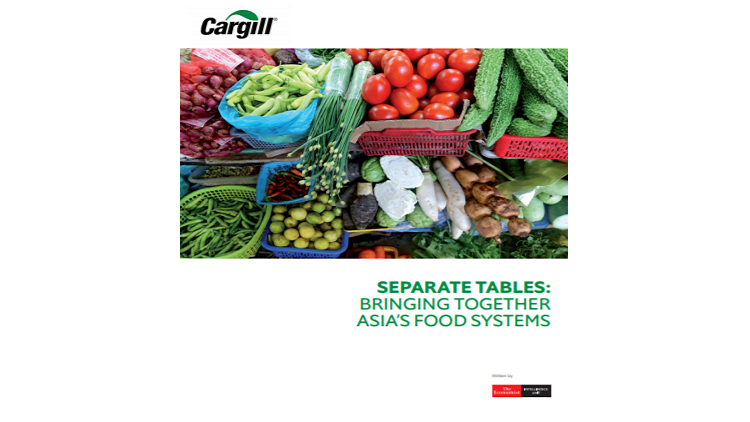Six Asian food system megatrends revealed by Cargill…and the opportunities they offer food firms

The report, Separate Tables: Bringing Together Asia’s Food Systems, was a joint piece of research by The Economist Intelligence Unit and Cargill, with the aim of providing regional context about food systems in Asia.
It also sets the scene for follow-up reports on more specific critical issues that Asian food systems will face from now until 2030.
“[It] is important to consider what the roads to 2030 will look like for different countries within Asia,” stated the report.
“Higher-income countries will grapple with concerns such as obesity, a decline in domestic food self-sufficiency and increasing awareness of sustainability issues.
“In lower-middle-income countries, the focus will be on undernourishment and stunting, as well as supply-side concerns such as closing yield gaps.”
“[Even] within countries, income inequality, infrastructure quality and rural-urban divides will drive different food system trajectories. This is particularly true in large countries such as China and India, where inequalities already translate into significant intra-country and inter-city differences,” it added.
The six megatrends in Asian food systems
The megatrends identified by the report were:
a) The dominance of urbanisation
In terms of urbanisation, Asia’s urban population will increase by 578mn to make up roughly 50% of the global urban population by 2030. Approximately 75% of these urban dwellers will hail from China, Indonesia and India.
As a result of urbanisation, the consumption of convenience food is expected to simultaneously increase. The report stated that processed food imports rose by over 100% between 2005 and 2015.
“The Global Panel on Agriculture and Food Systems for Nutrition estimates that sales of ultra-processed foods in East Asia and Southeast Asia will approach the levels in high-income countries by 2035,” it added.
One observation that would be of particular interest to manufacturers was the necessity for localisation in order to ensure product success.
“Oreos only became popular in China after they had been reformulated to include less sugar and the biscuits had been changed to wafers. Indonesians prefer snacks that are sweeter and available in smaller packaging,” it reported.
Increased trade, modern retail and regional food import competition were also predicted.
“[There will be] export opportunities for countries with strong agricultural sectors, and Asian countries converging towards heavier consumption of meat, fish, oil and sugar will begin to compete for imports from exporting nations outside Asia.”
“Today, imports for key staples already depend heavily on countries outside Asia.”
b) Diets becoming increasingly energy-dense
As the region becomes wealthier, Asians are also expected to shift towards a more energy-dense diet, but many of those calories will come from protein, fat and sugar instead of traditional carbohydrates.
“Income growth in Asia will continue to drive the transition away from direct consumption of cereals, particularly rice,” it wrote.
“Globally, it has been observed that people eat fewer direct carbohydrates as they become wealthier, but consume more cereals indirectly through meat.”
This trend is also likely to be accelerated by trade liberalisation.
c) The increasing double burden of obesity and undernutrition
That said, trade liberalisation is expected to affect obesity rates negatively, and undernutrition rates positively.
“On one hand, trade liberalisation can be a positive force in countries where the food supply is inadequate and calorie insufficiency is an issue [by increasing food availability],” said the report.
“On the other hand, […] trade can also encourage increased consumption of energy-rich food, leading several studies to highlight the links between obesity and trade liberalisation.”
It is also predicted that undernutrition rates in Asia will decrease somewhat from now till 2030, but “at rates that are insufficient to end all malnutrition” as per the United Nations Sustainable Development Goal 2.
d) Research and development as a key driver or agricultural development
Investments into research and development for agriculture in Asia is expected to continue to rise, though at less-than-ideal rates.
“Given the current level of research in Asia, there is significant room for R&D to expand in agriculture, particularly as investments have high expected payoffs in developing countries.”
“However, many countries in Asia continue to underinvest in agricultural research. Cambodia, Laos and Pakistan all invest less than 0.20% of their agricultural GDP in research, while China and India have relatively low-intensity ratios of 0.50% and 0.40%.”
As such, technological advancements are expected to vary widely between different Asian countries due to what are deemed as ‘institutional differences’.
e) Increased interest in food systems transparency and sustainability
Food systems transparency and traceability is becoming increasingly important to both developing and developed Asian countries, but for different reasons.
In developing countries like Vietnam and Myanmar, consumers are worried about food safety as “unsafe food remains a major cause of disease and death”.
With up to VND4.4bn (US$191,300) worth of food safety violations in the first half of 2018 alone, and inspections revealing over 68,000 businesses flouting food safety rules, Vietnam has good cause for concern.
“Food adulteration and fraud scandals have also increased consumer vigilance. Regulations in most countries are becoming stricter, driven by increased consumer awareness, food scares and greater local capability in food testing,” said the report.
In developed countries though, sustainability concerns are what drive the need for transparency.
“[Sustainability issues] are now beginning to attract more attention (albeit at a slow pace) among consumers in Asia.”
This trend is also driven by social media, globalisation and trade liberalisation.
f) Food politics
Lastly, the report predicts political clashes over resource allocation as well as water scarcity.
“As countries become more urban, decisions about how to allocate resources between urban and rural areas become more political. For example, the decision to protect farmers through the use of subsidies, price floors or trade barriers comes at the expense of higher prices for consumers in urban areas,” it said.
“By 2030, Asia is projected to need 65% more water for industrial use, 30% more water for domestic use and 5% more water for agricultural use. This increased need for water (coupled with declining resources) will drive water politics between upper and lower riparian countries.”
“Water-related tensions will worsen as demand for electricity and water increases in Asia. Energy demand is expected to rise by 27% […] by 2030.”
“China alone is expected to account for nearly one-quarter of global primary energy consumption by 2030,” it added.
Opportunities and recommendations
In view of these trends, the authors have also identified opportunities, challenges and recommendations for both policymakers and companies moving forward.
For companies, the recommendation is to first assess the trends above, and where they are likely to converge and diverge, then plan corporate strategies accordingly.
“When setting corporate strategies, companies could take into account the short-term and long-term implications of trends that are likely to converge and trends that are likely to remain divergent,” wrote the authors.
[Long-term] corporate strategies could incorporate likely [convergent] improvements in expressways or ports up to 2030, while recognising that institutional changes (such as metropolitan planning and local taxes) will remain divergent.”
Additionally, food and retail companies are urged to take note of localisation, as the convergence of a trend does not imply convergence to the norms in Western countries.
“For example, convergence towards modern retail is likely to happen, but modern retail in Asia will not be exactly the same as in other regions,” they said.
“Walmart’s failure to take into account local Chinese tastes led to a loss of market share to Sun-Art.
“Localisation is not just limited to country tastes; city-level tastes may be the driving predictor of localisation needs, given Asia’s rapid urbanisation.”
For policymakers, they first recommended that food security be defined more holistically, in order to cope with structural changes in food demand and supply.
“[Food] security considerations could be broadened to include other strategies, such as identifying diverse food sources, […] optimising local production through investment and research, and contract farming,” they said.
“These strategies […] have been implemented with success in Singapore—a country that imports 90% of its food but was ranked third in the Global Food Security Index 2016.”
Additionally, it is recommended that policies should move beyond just looking at rice and other staple grains.
They also urged policymakers to look to the above trends, look beyond the border for impacts, and pay attention to localisation and data-driven analyses when making and implementing policies.


















